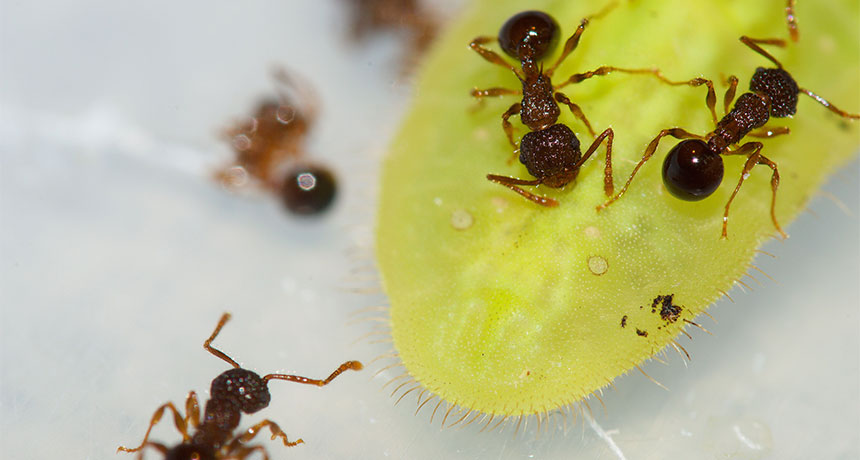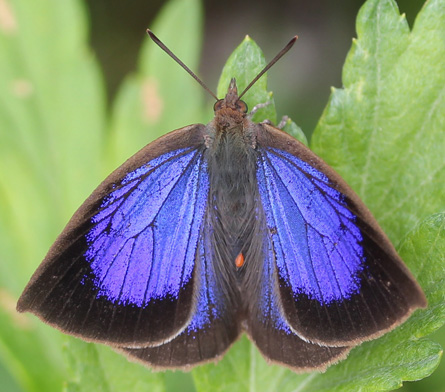
BUILDING BODYGUARDS Neglecting their colony tasks, ants hang around — and defend — a Narathura japonica caterpillar that oozes droplets spiked with substances that alter ant brain chemistry.
M.K. Hojo
Beware the caterpillar offering a juicy treat. Sips tweak ant brain chemistry, lulling the insects into neglecting their own colony in favor of hanging around the source of the marvelous droplets.
Effects on the brain help Narathura japonica caterpillars recruit a corps of ant bodyguards, says chemical ecologist Masaru K. Hojo of Kobe University in Japan. In lab tests, ants sipping these secretions scurried around less on their own initiative than normal ants do. Yet the low-key ants burst into frenzies of defensive aggression when the caterpillar showed alarm. Analyses of ant brains suggest that the caterpillar droplets change the concentrations of the chemical messenger dopamine in the brain. And that change may turn passersby into protectors, Hojo and his colleagues suggest in the Aug. 31 Current Biology.
What might look at first like a simple exchange of drinks for some ant muscle defense could turn out to be a trickier manipulation, Hojo suggests. This apparent mutualism could, in fact, be more like parasitism.
The Asian Narathura caterpillars belong to the Lycaenidae family of butterflies — a clan skilled in tricking ants. Some members of this family produce larvae that smell enough like larval ants that colony foragers mistake the caterpillars for lost brood and carry them home to feed and tend with real ant young.
The N. japonica caterpillars take a different approach to recruiting care. When ants palpate the right spots on the caterpillar’s abdomen, pores release a slightly sticky liquid. Ants of diverse species find the liquid attractive (though an individual caterpillar hosts only one species of ant). Biologists knew the secretions offered some nutrition to ants, but Hojo and his colleagues began to wonder if the allure was stronger.
Watching ants hanging out with caterpillars in the wild, Hojo noted that ants accustomed to droplet feeding don’t seem to return to their colonies much, if at all. Instead of searching for food and carrying it home, “they forget about colony tasks,” he says.

Lab tests showed that caterpillar-doped Pristomyrmex punctatus ants run around less in general, but they erupt into action when caterpillars raise their tentacle organs. These fleshy fingers, normally flattened near the caterpillar rump, stretch up when a spider, parasitoid wasp or other danger looms. When Hojo provoked lab caterpillars to raise their tentacles, ants that had not fed on caterpillar droplets mostly ignored the action. But ants that had been lapping secretions for at least three days rushed around excitedly as they do in a crisis. Ants make formidable fighters and can tackle predators that caterpillars can’t.
Tests showed that the brains of habitual secretion drinkers are lower than unexposed ants in dopamine, a substance known to affect activity and aggression in fruit flies. Researchers then used the drug reserpine to block normal ant brains from transporting dopamine. The ants became less active as they do when licking caterpillars.
The dopamine scenarios for manipulating ants sound possible to neuroscientist Serge Birman of ESPCI Paris Tech. Dopamine deficiency in fruit flies reduces their tendency to run around, he and his colleagues reported in 2011.
Plant ecologist Martin Heil is certainly open to the idea that what looks like a mutualistic trade of food for ant services could include partner manipulation. Heil, of the Mexican research center CINVESTAV in Irapuato, has seen something like it before. In 2014, he and his colleagues reported a manipulative twist for acacia trees seeping outside-the-flower nectar that attracts ant bodyguards. The acacia nectar doesn’t carry the usual floral sugars and it’s spiked with an enzyme that disables ants’ digestion process for normal sugars. So the acacia bodyguards aren’t likely to wander off to other flowers. What looked like trading included some tricking.





